SKY PUP NEWS
Newsletter No. 20 Summer, 1988
- Oshkosh '88 Convention
- Heart of Illinois Fun-Fly '88
- Another Illinois Sky Pup Found
- Iowa Sky Pup Ready For Fabric
- Miscellaneous
- Ideas and Tips from Ken Thompson
- Covering and Glues
- Isolated Instrument Panel
-------------------------------------------------
SKY PUP NEWS is a quarterly newsletter for builders of the Sport Flight “Sky Pup”. the purpose of the newsletter is to provide for the open exchange of information and to encourage builders to share their experiences of building and flying the Sky Pup. Beginning with this issue, the newsletter will be written by Sky Pup builders and enthusiasts. Unless specifically stated, all ideas, suggestions and building tips are strictly the opinion of the contributor an have not been approved by Sport Flight Engineering Inc. No warranty is made as to the airworthiness or suitability of modifications or building tips. When in doubt, you should follow the plans as close as possible and contact Sport Flight Engineering if you have questions. SKY PUP NEWS is compiled and distributed by Dan Grunloh…Rt 2, Box 82, Potomac, Illinois, 61865. Subscriptions are $7.00 for the calendar year ($10.00 overseas). If you want to talk about the Sky Pup, or about airplanes and homebuilding in general, please feel free to call me at (217) 569-2121 late evenings. Please keep sending your letters and photos.
Oshkosh '88 Convention
Oshkosh '88 was a big first for the Sky Pup. Two Pups were on display. Gerry Coppock's "Dog House" was there for the third time and I had my Pup SN2028 up there for the second time. Really have to thank Gerry because he arrived a day early and claimed the best spot in the tiedown area for us. We had the only shade available and some shelter from the winds. This year was the hottest on record and also one of the windiest. The ultralight runway was shorter and the approach was even tighter, if that's possible. All operations were to the south only, as some flight periods were distinctly downwind. Though formation flying was prohibited in the pattern, Gerry and I "accidentally" flew side by side during one of the flights. It was a real thrill to look over to my right and see another Sky Pup off my wingtip. A friend of mine had taken photos of the two Pups together in the air but I haven't yet been able to get a copy of the print.
There were over 20 Sky Pup builders and owners who stopped by to see our Pups sometime during the week. Thanks guys. Incidentally, the photo on the right shows Gerry's Pup tie down in front of the ultralight headquarters in a place of honor. Actually, the ultralight chairman stated that some of the regular EAA homebuilt members were saying that there were very few "real" ultralights down on our end so Gerry's was chosen as an example for display.
Late in the week, after Gerry had left, a severe thunderstorm passed directly through the area. Winds were over 50 mph, rain came down in sheets, flagpoles were permanently bent, and my tent poles snapped like toothpicks. After it cleared, I hurried over to check on my Pup and was delighted to find it still intact. Witnesses said that my Pup and other ultralights were literally flying off the ground on the ends of the ropes. I didn't have them tight enough. A very detailed inspection showed no damage whatsoever. It's one tough bird.
Heart of Illinois Fun-Fly '88
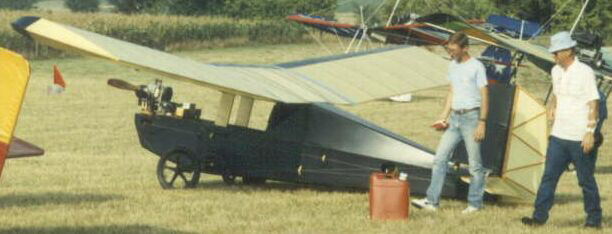
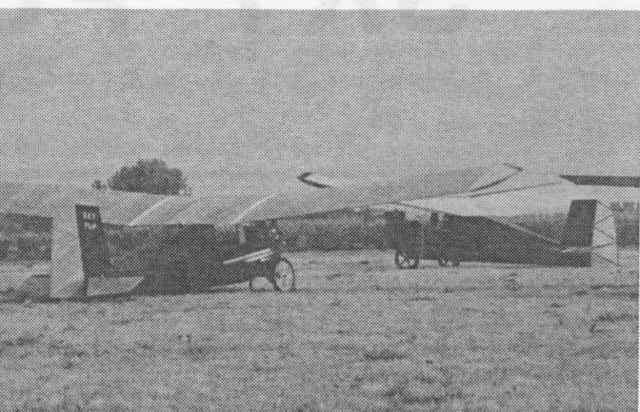
In August of this year a local ultralight club, The Heart-of-Illinois Ultralight Club, sponsored it' 5th annual Fun-Fly near Pekin, IL. This was an ultralight only fly-in with a full complement of contests and about 18 ultralights attending. Club member Allan Mays of Bloomington, IL was there with his Sky Pup SN1834 (see newsletter no. 15). For the first time I made it there with m Pup SN2028 so the Sky Pups had a good showing. The photo on the right shows Allan's Pup which is dark navy blue and yellow and is Cuyuna powered. On the left is Allan getting read for the parachute drop, and the big guy on the right is Sky Pup builder Keith Stacy from Buffallo, Iowa. As it turned out Keith made the first flight of his Pup only 10 days after this photo was taken. The parachute drop is a bit easier than the bomb drop because you don' have to lead the target, just make sure to allow for wind drift. Unfortunately, I didn't do very well in the contests because many of the pilots had been practicing a lot. I trailered my Pup to the site because it was about a 100 mile trip for me, and I could not locate a convenient fuel stop. The prize for the pilot to fly-in from the longest distance went to the owner of a Kolb Flyer who arrived from St. Louis, MO which is at least 250 miles. If you get a chance to attend a fly-in like this, don't miss it.
FIRST FLIGHT!! Keith Stacey of Buffalo, Iowa, called in an excited state to say that he had made the first flight of his Pup (SN1892) on August 30, 1988. See also newsletters no. 18 & 19. He had already completed taxi testing and had hopped the Pup up to 20 ft. On his second lift off he found himself drifting off the runway and decided to continue climbing and fly the pattern. Keith said he had enough butterflies about that first flight he could have flown without the engine! Once airborne he said he was not nervous at all (too busy). As far as he could recall, pitch trim came out OK with a C.G. of 9 inches. I asked Keith of his impression of the cockpit after his first flight as I have always found it rather comfortable and cozy. Keith says, "The cockpit hugs you". He has experimented with a Hall ASI mounted on the wing upright and connected to a remote pitot on the end of the axle with a plastic tube. The remote setup worked fine when tested on his pickup truck but may be reading too low on the Sky Pup. Possibly the input is affected by the propwash, or the static port is in a high pressure area.
First plans built Pup is flying again. Neil Huizenga of Grandville, Mich. who is the new owner of SN1092 reports he has this historic bird back into the air again. The original builder was Ray Macke. See newsletters no. 1, 16, and 17. Recurring problems with the engine tuning and mismatched props which plagued previous owners was traced to poor engine compression. New set of rings in the Rotax 277 cured the problems. Neil says the Pup flies just fine now.
IDEAS AND TIPS FROM KEN THOMPSON
Ken Thompson of Kennesaw, Georgia is a Sky Pup builder and an aeronautical engineer with 30 years experience in the aircraft business mostly at Northrup and Lockheed. He is currently supervisor of the Flight Control Group at Lockheed-Georgia. Ken has investigated some of the questions and decisions facing the Sky Pup builder of today (five years after the plans were introduced). His findings should be of interest to anyone currently building a Sky Pup. My thanks to Ken for his well written letter and a fabric sample he sent. The Koverall fabric is tougher than the sheath lining and should be easier to handle. Here's a summary of his letter.
Covering materials
Sheath lining.... I covered my rudder with Butterfly sheath lining and decided against using it. I've heard the sheath lining will shrink 2-3% but mine didn't seem to shrink at all. The addition of paint made it sag even worse. I also grew to dislike water based contact cement during this exercise.
Coverite.... Coverite is a model airplane covering material - an iron on, heat shrinkable cloth with adhesive backing, Coverite weighs 3.5 oz per yard and costs about $28 for 5 yards, 46 inches wide.
Koverall.... This lateral I've zeroed in on for my Pup is made by Sig a model airplane manufacturer. Koverall is a heat shrinkable (about 10%) Ceconite and weighs about 1.8 oz per yard. Koverall (unlike most model airplane cloth) does not have a heat activated glue backing. Koverall is available from Tower Hobbies in Chicago for about $10 for 5 yards, 48 inches wide.
Glues to attach covering
Water based contact cement...., I've given up on using water based contact cement as I haven't found any which will dry out. They all remain sticky forever. I've tried Elmer's Safe-T, System 77 by Monsanto, and Dave Brown’s Southern Sorghum. (designed for sheeting foam wings with balsa) water based aliphatics..I tried a variety of these so called ''white" glues with some success. The big problem with them is drying time - 20 minutes to an hour and you have to hold the material in place and taut until the glue dries. I included Tower Hobbies Quick Sand, Elmer's Glue-All, and Titebond.
Standard aircraft fabric cement-.., I decided on using one of the standard aircraft type glues for attaching the cloth, Stits Poly-Tak. These types all dry quickly. can be reactivated with heat, an ensure a strong bond. They also eat styrofoam like it was going out of style. Therefore, at least two liberal coats of polyurethane are required on all the foam.
Engine selection
Cuyuna 215.... I thought this would be the logical choice. It seems to have adequate power at a lower cost than the alternatives. However, some Cuyuna 215's produce more like 12 or 14 hp instead of the rated 20 hp and I could not find a redrive for it.
Kawasaki 340.... This engine, according to J-Bird in Wisconsin, has more power, less weight, is smoother than the Rotax 277, and costs less. By the time you add carb, exhaust, pull starter, etc. it weighs about the same as a Rotax 277 and costs $300 less. I could not find an up-redrive for it.
KFM 107ER This electric start engine seems to have the right hp at the right weight but it is expensive - about $1900 in the latest Wicks catalog. It
would also be difficult to mount in a Sky Pup and I've heard comment to the effect the KFM is temperamental and may not put out it's rated hp.
Rotax 277.... I plan on using a Rotax 277 fan cooled with an upright 2.58
gearbox or a cigar upright 2.50 belt drive. The reason I've decided on a fan cooled engine is that several Pup builders have mentioned overheating problems with the free air Rotax and upright gearbox combination. Wayne (son of TEAM (Minimax, Himax etc.) ran into the same overheating problem with this engine gearbox combination. Wayne suspects that since the hub of the prop is almost directly in front of the cooling fins, very little air flows over the cooling fins. After making layouts of the various engine installations, I conclude that an upright Cuyuna 215 or Rotax 277 is the best way to go (just like Steve Wood designed it).
Tail Wheel..... I decided I'd like a steerable tailwheel so I wrote to Ray Macke and Jesse Buckle to see how they did it. I also checked with TEAM and liked the Minimax design best of all. The aluminum leaf and steerable wheel assembly costs $33 and bolts right into the Sky Pup.
Canopy and instrument panel.... I liked Ray Macke’s hinged-to-one side canopy and worked up a similar design which I may or may not have done by first flight time. I also liked his idea for an instrument panel and I'll probably try something similar. See enclosed sketches.
Controls.... I'd like to install a two lever throttle quadrant (throttle and choke) on the left side of the cockpit. I would also like to revise the stick to 2-axis, rudder and elevator, and run the rudder cables inside the fuselage.
I learned to fly in an Eipper MX II and I've flown a Maxair Hummer setup this way. I find this arrangement to be the easiest control system for me. I have to work harder in a conventional 3-axis machine. However I am not a high time pilot by a long shot
Ken writes that his Sky Pup is partially completed and he hopes to have it flying by the end of the year. He would like to do the initial test flying himself but might change his mind on that. He has a U.S. Ultralight Foundation Pilot license (5 hours dual instruction) but only has about 20 hours of total flying time.
(newsletter no. 20)
Another Illinois Sky Pup Found

Last year at Oshkosh, I met a builder from Illinois who said he had completed a Sky Pup and liked it very much. However, I didn't get his name. This spring, Al Mays reported seeing a Pup parked near a barn somewhere in his area but he could not locate the owner. Fortunately, the builder, Ray Johnson, returned to Oshkosh again this year and provided these photos of his Pup which appears to have been built very much "per plans". The color is all white and the vertical fin has a sketch of "Snoopy" leaning back and wearing sunglasses (very much in the spirit of Gerry Coppock's Pup). He has a neat curved cowling over the fuel tank and instrument panel. Though I'm not certain of the engine, it appears to be a free air single cylinder with belt drive (possibly a Zenoah 242?).
Iowa Sky Pup Ready For Fabric

Clyde French from Grinnel, Iowa sent these photos of his Pup SN2148. At this point the airframe is essentially completed and is ready for varnish and fabric. The colors will be a blue and yellow sort of WW-I trainer pattern. Clyde was at Oshkosh this year and wrote that he finally got to see the two Pups flying as he was leaving on Wednesday morning. He was heading south on the highway as Gerry and I flew overhead in the ultralight pattern. Clyde writes that he is now struggling with the fabric covering and finds the latex "milk" rather difficult to work with. Here's my advice: use good quality foam brushes to apply a uniform layer of the latex fabric cement. Slow steady strokes in one direction are best. Do not brush over wet areas and yes, it does stay slightly tacky for a long time after soaking into the fabric. It doesn't seem to affect the strength. Just give it a few days to dry and varnish right over it.
Miscellaneous
A classified ad seen in "Western Flyer".....SKY PUP, with trailer. Removable wings, 277 Rotax fan cooled, gear drive 54x27 prop. Zero time. Will deliver. $3000. (206) 927-6821 or (206) 833-8001. A phone call revealed this Pup is owned by newsletter subscriber Jesse Denzler of Auburn, WA. He says the color is yellow and white, looks very nice, and has good craftsmanship. He and his partner had prior experience building experimental aircraft. His partner is currently flying a KR-2. The Pup has a tailwheel, has been taxi tested, and is ready to fly. Reasons for selling; insurance problems, no time to mess with it, and no place to fly. His airport prohibits ultralights!
Here's some more classified ads seen recently:
* Rotax 277 - low time with gearbox, 60x28 prop, muffler, $600. (206) 392-9744
* Rotax 277 - gear reduction, complete prop/tank exc. $595. (404) 629-1572
* Anyone need a flyable Sky Pup? No engine. Cheap. (613) 224-3649 Ottawa, Canada
More Miscellaneous
My thanks to Paul Pontois who sent a copy of an article on the Sky Pup he wrote for his local ultralight club newsletter. It was well written and should motivate me to write an article I have promised on the Sky Pup for the EAA magazine. Also...just as this newsletter was going out to the printers, I received word that Donald Diggs of Monon, IN, has completed and flown his Pup (see issue no. 13). I will have full details and photos on the very nice Pup in the next issue.

Original Newsletters edited by Dan Grunloh, electronic edition compiled by Edwin Lelieveld and Roger Ford.
Sky Pup News

June 12, 1988
Dear Sky Pup Enthusiast,
It is time once again for me to apologize for sending this issue out so late. In particular, I want to apologize to the newer subscribers who may have worried that something had happened to me or that I had decided not to continue the newsletter. Sorry..... These issues have always been behind schedule. The April issue is usually the latest because there is less new flying activity during the first quarter than at any other time of the year. I am especially short of photos to use in this and in future issues. Surprisingly, a number of builders who are almost completed or already flying have stated that they haven't yet taken any pictures of their bird! Please be assured I intend to continue to publish 4 issues per year even if the schedule is somewhat erratic.
I now have 90 hours on my Rotax powered Pup and a few repair items may be of interest. After two years and the equivalent of 3 months of sun exposure the upper D-cell wing varnish had begun to deteriorate. I had applied only two coats of polyurethane to the plywood portion of the wing to save weight. The color is dark brown and the D-cell heats up quite a bit when it is parked in the sun. Where the varnish had overlapped to make 3 or more coats, the finish was like new but elsewhere it had become cracked and very rough. The underside of the D-cell and other parts of the aircraft also dark brown were still like new. After I sanded the upper surface smooth and added the 3rd and coat, the overall performance and climb rate definitely improved.
More important than the wing varnish, I also have discovered vibration induced wear in the rudder bar assembly. The center pivot bolt and the two end bolts which hold the turnbuckles are fitted with castle nuts and cotter pins. The bolts are loaded only in shear and the nuts are only for bolt retention so they are kept barely snug. If the bolts loosen up a little, they can rattle and vibrate due to proximity of the engine. The cotter pins prevent the nuts from coming off but do not lock the nuts firmly. When I discovered mine had loosened up, I removed the cotter pin and attempted to tighten the nut. It spun freely on the bolt without any threads!!! The cotter pin itself showed no wear, but the threads under the bolt were completely worn away. All 3 bolts in the rudder bar assembly were affected though they looked normal during routine visual inspection because the exposed threads on the ends of the bolts were still OK. The center hole in the rudder bar was also worn slightly oversized so the rudder bar can now wobble slightly. I will either add a bushing or replace the rudder bar using maple instead of fir. I replaced the worn bolts and used mechanical (staked) stop nuts.
Though castle nuts and cotter pins are preferable, they must be kept snug if they are subjected to engine vibration. Does anyone reading this have more than 100 hours on a Rotax powered Sky Pup? If so, please let us know about any vibration induced wear you may have discovered.
Here's a reminder about the Rotax gear drive. While conducting the repairs mentioned above, I decided it was time to change the gear oil. Immediately after takeoff on the very next flight, I discovered hot oil was coming out of the vent tube and spraying all over the engine, pilot, and front of the wing. I had never had this problem before. After landing I realized I had mistakenly filled the gearbox to the upper hole instead of the lower. I had failed to notice that I added 3 times as much oil as I had drained out. Always fill to the lower hole.
BRIAN'S FIRST TAXI TEST
Brian Helsaple of Seiad Valley, CA (newsletter no. 18), writes that he has begun taxi testing his Pup. He trailered the bird to a 3000 ft. paved strip 1-1/2 hours away down a narrow winding road. He reports he had some difficulty with directional control on the narrow runway and elected to put his feet down to stop rather than taxi into parked aircraft. One foot was caught and dragged under the axle. The Pup nosed over but thankfully he had installed a nose skid which prevented damage to the prop. Being advised that a fast taxi in a straight line gives better directional control, he made another attempt with more power and neutral stick. This time he traveled the length of the runway with still too much weaving and tail bobbing. Becoming discouraged, he asked his instructor, who flies a Taylorcraft, to give it a try. His high speed run tracked a straight line the length of the runway with the tail held several inches off the pavement. Brian could see the "rudder dance" and realized he just had to practice more and get the feel of it. With only one good foot left, but with renewed confidence and enthusiasm, he climbed back in to try it again. With each pass down the runway his control became better and it started to feel like the control he had with the Taylorcraft. However, on the last run he again had too much speed at the end of the runway and had to put down his other good foot or run into the fence. It too was bent under the axle and twisted; but, he had learned a lot. He now could taxi back to the hangar flawlessly but had to have help to crawl out of the Pup. (The Sky Pup can be difficult to handle on a narrow paved runway with no brakes or tailwheel. It will coast a long way and directional control is reduced at slow speeds without a tailwheel. It's best to start out on a wide grass strip.)
Brent Adams from Saskatoon, Sask. wrote in January saying it was -40 degrees outside and his Pup is stored away until Spring. The big news is that he is working full-time now in the ultralight aircraft industry for the makers of the Husky Norseman single and 2-place Canadian ultralight. This international company recently shipped 160 aircraft and kits to India. Brent says he has been working long days painting all the aircraft but hopes to be moving up the ranks soon. In his spare time he his working on two aircraft. One is a 88% scale replica of the Christian Eagle and the other is a 2-place Norseman which he will use to give flight instruction. He plans to be at Oshkosh this year but bringing his Pup along is still a big "IF'' because of the distance.
HOPE TO SEE YOU AT OSHKOSH..........DAN
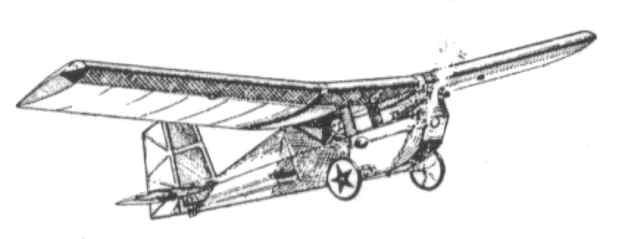
SKY PUP NEWS

Newsletter No. 19 April, 1988
- Ski-Pup Still Going Strong
- Tips From Newsletter Editor's Pup
- More News
- Miscellaneous
- Newton Bordon's Wing Gap Cover Fastener
- Letter from the Editor
- Maintenance Issues
- Brian's First Taxi Test
-------------------------------------------------
SKY PUP NEWS is a quarterly newsletter for builders of the Sport Flight “Sky Pup”. The purpose of the newsletter is to provide for the open exchange of information and to encourage builders to share their experiences of building and flying the Sky Pup. Beginning with this issue, the newsletter will be written by Sky Pup builders and enthusiasts. Unless specifically stated, all ideas, suggestions and building tips are strictly the opinion of the contributor and have not been approved by Sport Flight Engineering Inc. No warranty is made as to the airworthiness o suitability of modifications or building tips. When in doubt, you should follow the plans as close as possible and contact Sport Fligh Engineering if you have questions. SKY PUP NEWS is compiled and distributed by Dan Grunloh…Rt 2, Box 82, Potomac, Illinois, 61865. Subscriptions are $7.00 for the calendar year ($10.00 overseas). If you want to talk about the Sky Pup, or about airplanes and homebuilding in general, please feel free to call me at (217) 569-2121 late evenings. Please keep sending your letters and photos.
Ski-Pup Still Going Strong
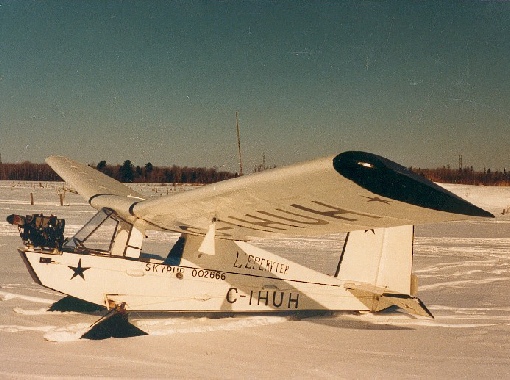
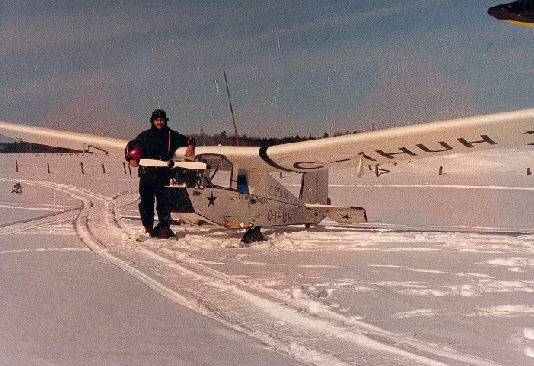
These photos show the ski equipped Sky Pup built by Jean Claude Hivon from La Perade Quebec. SN2666 has been reported in newsletters no. 13 & 14. The skis are 4 ft. long and 7 inches wide and work very well even in a crosswind as they will slide sideways if needed. With the skis, he can land almost anywhere there is snow, even behind his house. The skis work great but a little more horsepower is needed when the snow exceeds two feet in thickness! The Pup reportedly flies extremely well in very cold weather. He is often flying in weather as cold as -5 degree F. and says he flew almost 20 hours in December and January. It would be impossible without the windshield he has added and without the hole in the floorboard closed over. With these two additions he can fly without a visor on his helmet. The windshield is simple and weighs very little. The frame of the windshield is made from 3/4 pine and only the two bars of the front are laminated to give the round shape. He says he has found a new engine which is one inch lower, one inch shorter, and weighs 4 lbs. less even with the electric starter and battery (his previous engine must have definitely been too heavy). To make the pulleys for a reduction drive, he melted down an old lawn mower engine in an iron pot. The melted aluminum was poured into a 2-1/2 inch can for the small pulley and a 6 inch can for the large pulley. He only had to finish them on a lathe and they worked just fine. He bought the engine for $60.00 at a flea market. How many of us can show that much ingenuity. If you wish to contact Jean Claude about his windshield or skis, see his address in the enclosed mailing list. You should realize however, his first language is French!
Tips From Newsletter Editor's Pup


I would like to pass on a couple of tips from my own Sky Pup SN2028. The photo on the left shows the arrangement for using the recoil starter on the Rotax 277 while seated in the Pup. An extra steel wing attach bracket (which was mis-drilled) is mounted to the top of the cylinder head with the appropriate size metric bolt. A swivel pulley is then attached with a threaded chain link. The recoil housing on the Rotax can be removed and rotated to any desired position. I also added a short loop of rope so I could easily reach the handle without leaning too far forward. I must confess I have still not attempted an in-air restart. The arrangement works well but I still usually use both hands to pull on the starter. My Pup does not trim hands-off so I will have to pull the rope with one hand which is a little more difficult. I'm not sure how this would work if I were to add a windshield. The photo on the right shows a method for supporting the aft end of the Rotax muffler. A universal muffle hangar from an auto parts store was adapted by mounting it on an extended landing gear bracket. The rubber strip on the muffler hangar allows for movement of the landing gear and for engine vibration. The bracket is attached to the tailpipe with a stainless steel hose clamp. the muffler should also be safety wired to the landing gear in case the rubber breaks. Incidentally, when mounting the Rotax exhaust on my Pup, I cut a pie-shaped slice out of the header tube and had it welded back together. This angled the exhaust further outward to give better clearance from the engine mount and side of the fuselage.
Newton Borden sent this tip for fastening the ends of aluminum wing gap covers. His were made from gutter aluminum. A short piece of heavy angle was riveted to the bottom end and a hardwood block was fitted to the bend around the trailing edge. A bolt and wingnut pulls the cover tight and he says it doesn't loosen up in flight. The edges of the gap covers were fitted with rubber channel from Wag-Aero (catalog# H796-000).

Congratulations to Gerry Coppock whose Sky Pup, "Gerry's Dog House", was pictured in the June 1988 issue of Air & Space Smithsonian magazine. A color photo of his Pup at Oshkosh is included in the calendar of events with a caption that says, "Imaginations and designs run wild at Oshkosh". Of course, we all know they picked the best design at the whole show.
More News
Oshkosh '88 is July 29th to August 5th. This year, there should be at least two Pups present (mine and Gerry Coppock's). Two more Pups are possible. This year will be the 5th anniversary of the introduction of the Sky Pup to Oshkosh. It would be nice to have a generous litter of Pup on display. Even if your Pup is not yet flying, why not consider bringing it along. There is no additional fee to display aircraft. Static displays are welcome too! Sky Pup designer Steve Wood, who has been unable to attend in recent years, has stated that he will definitely try to be there this year. Also in the news, there will be some changes in the layout of the ultralight area this year. The runway and tiedown area will move more southward, but the commercial ultralight exhibit area will still be near Gate 7A at the south end of the convention grounds. To find Sky Puppers camping at Oshkosh, look for "Ollie's Birds Eye View" campground which is a house, barns, silo, etc. near the ultralight entrance (far south of the control tower, east side of Knapp street).
Andre St-Pierre from Pointe de Lac, Quebec, sent a letter updating progress on his Sky Pup SN3099. He started in October 1987, and has completed the tail and wing panels as of April 1988. He decided on building the Pup after seeing examples in his area (Paul Pontois and Jean Claude Hivon). Andre is 46 years old, always wants to fly since he was a teenager, and works in the engineering department of Hydro-Quebec. He had trouble finding 3/4 inch foam but located a source of some new types of Dow Styrofoam which are used for highway insulation in cold climates. He graciously sent samples of foam and technical data from Dow to me, and to Sport Flight. One type in particular, HI-100, show especially good structural strength.
W. Keith Stacy from Buffalo, Iowa reported in a recent phone call that his Pup is completed and will fly any day now (see previous newsletter). The Kawasaki 340 engine has a reduction drive mounted downward and the 54 inch prop gave only marginal ground clearance. In fact, the tip was broken off during ground handling. He now has a 48 inch prop giving a max RPM of 6100. Keith says he has plenty of experience in conventional aircraft but no taildragger time.
Kenneth Thompson from Kennesaw, Georgia, called to say he has begun the fabric covering on his Pup. He noticed the latex cement stay tacky for several days so he is experimenting with an aliphatic glue which dries much faster. His fabric is "Coverite" model airplane fabric (actually 1.5 oz. dacron) which is 48 inches wide and cost less than $2.00 per yard. The finish will be exterior latex paint.
Paul Rasmussen of Des Moines, Iowa, writes he has made a few changes on his bird (see newsletter no. 14). His ballistic parachute is no mounted on the seatback bulkhead so it fires upward through the fabric. It's original location above the centersection resulted in turbulence which caused the tail to vibrate. He also devised a shock absorbing instrument panel that works. Paul also says he was visited by two other builders, Roy Snider and Clyde French.
Sport Flight Engineering has announced they have discontinued sales of Sky Pup plans and related items. Their letter states, "The Sky Pup has been a successful design and we are pleased that so many builders have enjoyed it. However, schedule obligations in our design consultation business prevent us from continuing to market plans and providing builder support indefinitely. We will continue to answer questions for builders who already have plans as long as a reasonable level of Sky Pup activity exists." This shouldn't be a problem for future builders as over 2000 sets of plans were sold over the 5 year period. There are plenty of unused plan sets in circulation and most builder questions were covered in the first 9 newsletters which were published by Sport Flight. I plan to continue the newsletter as long as possible to help Sky Pup owners stay in contact and pass on any new ideas or maintenance problems associated with age or extended use.
Miscellaneous
Burt Taylor, writes that he has bought a Chotia 460 engine from a Weedhopper to use on his Sky Pup. If you can offer any ideas how to mount it, his address is: 210 Doris St., Springfield, OR 97472.
Thanks to A.R. Clements and Brent Adams who sent me copies of articles from the Canadian Ultralight News which showed photos of my Pup at Oshkosh '87.
Sid Coleman is looking for information on the "Ultra 275" opposed twin cylinder engine for his Pup. Write to 1015 E. Navajo #3, Farmington, NM 87401.
Plans and Wicks Kit for sale... Donald Zimmerman, Rt. 3 Box 563, Mt. Juliet, TN 37122 wants to sell it all for health reasons.
Frank Crother of La Crescenta CA, says he is planning to build a 1/4th scale RC model of the Sky Pup.
Floyd Washburn, P.O.B. #9, Campe Verde, AZ 86322 wants to buy a set of plans.
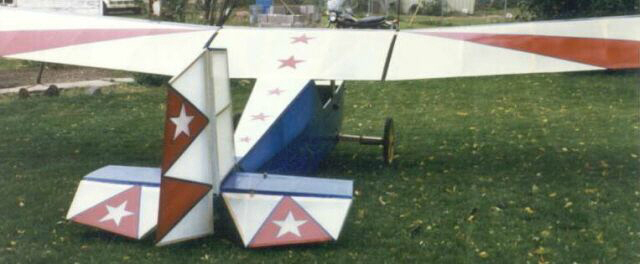
SKY PUP NEWS

Newsletter No. 18 January, 1988
- California Sky Pup Ready!
- Wright-Patterson Pup for Sons
- Canadian Pup Flying in British Columbia
- Another Sky Pup from the Michigan Litter
- Some Tips On Color Selection
- Miscellaneous
- Brakes on "La Tulipe"
- Highly Modified Pup with Ailerons
-------------------------------------------------
SKY PUP NEWS is a quarterly newsletter for builders of the Sport Flight “Sky Pup”. the purpose of the newsletter is to provide for the open exchange of information and to encourage builders to share their experiences of building and flying the Sky Pup. Beginning with this issue, the newsletter will be written by Sky Pup builders and enthusiasts. Unless specifically stated, all ideas, suggestions and building tips are strictly the opinion of the contributor an have not been approved by Sport Flight Engineering Inc. No warranty is made as to the airworthiness or suitability of modifications or building tips. When in doubt, you should follow the plans as close as possible and contact Sport Flight Engineering if you have questions. SKY PUP NEWS is compiled and distributed by Dan Grunloh…Rt 2, Box 82, Potomac, Illinois, 61865. Subscriptions are $7.00 for the calendar year ($10.00 overseas). If you want to talk about the Sky Pup, or about airplanes and homebuilding in general, please feel free to call m at (217) 569-2121 late evenings. Please keep sending your letters and photos.
California Sky Pup Ready!
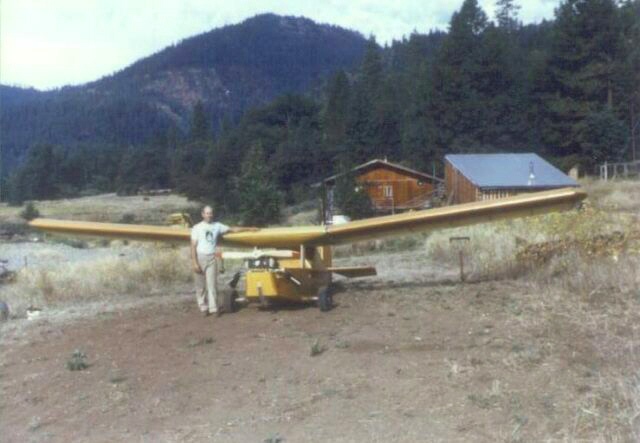
Shown above is the yellow Sky Pup built by Brian Helsaple from Seiad Valley, CA. The engine is a highly modified 1969 Rotax 377 opposed twin cylinder. The bulky air cooling shroud an flywheel were drastically remodeled with a hacksaw and file. Cylinder heads were no longer available so two Yamaha heads were modified to fit. Also, no parts were available for the pull starter so he fabricated his own which involved lots more modifications. The result is beautiful horizontal opposed twin-cylinder (2-stroke), with custom made tuned exhaust. The fuselage was widened 10 inches due to his original intention of taking his nephews an nieces for a ride. He now recognizes that idea is illegal and unwise and won't be considered for the Pup anymore. Since no 3/4 inch foam was available, one inch was used throughout. Add to that the fat wheels and tires, and the empty weight comes out to 234 lbs. Total construction time for the airframe was about 240 hrs but much additional time was spent modifying the engine.
Brian taxied the Pup for two days and felt confident until he chopped the power and the Pup headed for the oat field (he was concerned about setting it on fire). A week later, fire did break out in the surrounding forest. It was 60 days of smoke and many t-shirts later that the winter rains came. Another drawback of his runway involves the bald eagle. He lives in a beautiful scenic area which has a sanctuary closed to all human activity from January to July. the nearby nest site is the only one in western California. He can take-off but must carefully avoid the area as do the loggers and miners. Brian says the Pup is ready to fly and he ha considered trailering the Pup down 65 miles of difficult roads to a seldom used commercial airstrip in Montague. He wants to fly it real bad!
Wright-Patterson Pup for Sons

The photo above shows Sky Pup SN3071 being built by Captn. Stan Duncan USAF (Dayton, OH) and his two sons Dane (14) and Shad (13). The dog's name is Nicki. The only items are to cover the wings, the control system, and the fuel tank. They are presently looking for used powerpack. Stan says he chose the Pup because of its low cost, and because it's a good safe design. With a large family, and two sons who want to fly, a low cost design was the driving consideration. He began with the idea the Dane and Shad would do much of the work (with his help). However, he got so involved, it became his project. He says he is looking for a place to get dual ultralight instructions for the two boys. Their project is being built in a very small garage which has no power, heat, or light. Hence, they have shut down for the winter until the days get longer, and the weather warms up. Stan is a private pilot with many hours in taildraggers, and has restored a 1946 Cessna 120 which was sold a year ago. His second love is antique automobiles, and he is currently restoring a 1942 Chevy Roadmaster pickup. Captn. Duncan is currently stationed at Wright-Patterson AFB where he works as a development engineer in the Flight Equipment Branch of the Aeronautical Systems Division. Translated, that means he works on things like the landing gear, fuel system, brakes, and airborne environmental controls. Sky Pups are a lot simpler.
Canadian Pup Flying in British Columbia
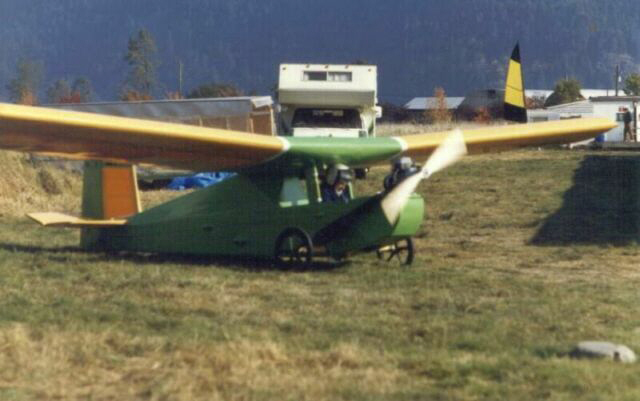
A.R. Clements from Sechelt B.C. sent this photo of his green and yellow Rotax powered Pup which made its first flight in September 1987. Early details were reported in issue no. 17. the project was started in November '86 and completed in June '87. He has 7 hrs. logged to date. He hadn't flown for 2-1/2 years and that was only a 6 hour instruction course. For the first flights, he trailered the bird to an ultralight field in farm country (no trees) and found the camaraderie and enthusiasm much greater than at the regular airplane clubs. He was amazed how delightfully the Pup lands; perfectly every time. It's easy to fly and will take off in four seconds, but he doesn't know the climb rate because the Pup has no instruments. Mr. Clements is 60 years old and has wanted to fly all his life. For now he is content to fly in circles at low power. According to rumor, there is another Sky Pup nearing completion somewhere in his area. In closing, he asks the question: could cold and heat affect the laminations in the airframe? (My own Pup was stored during construction, and after completion at temps from -20 to 100 degrees F with no problem. Reportedly, wood and foam have similar rates of thermal expansion. The real enemy is moisture! Wood to wood bonds could definitely be affected, depending on the type of wood, and the grain orientation. One builder has reported that his hardwood tailskid delaminated.)
DISC BRAKES ON ''LA TULIPE''
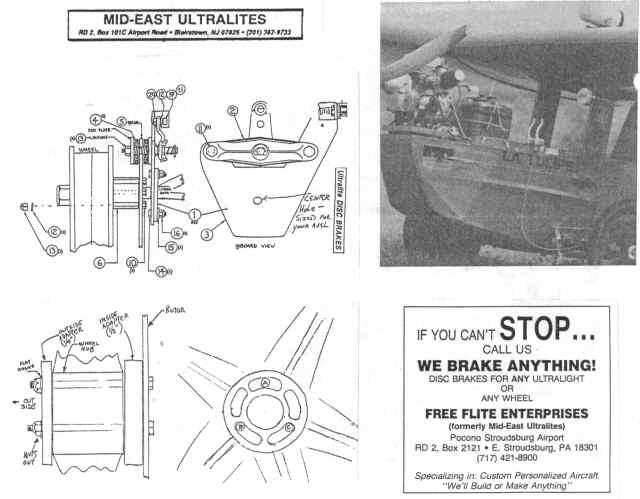
Paul Pontois sent details of the disc brake installation on his Pup SN 2236 (see newsletters no. 12 & 13). The kit disc costs about $200 and adds about 6 lbs. The installation requires a change to a solid stub axle and wheel bearings which will add a couple more lbs. The brake system can be fitted to almost any wheel. On the plastic 20 inch wheels, the rotor is attached to the wheel with bolts through the holes around the center hub. Paul mounted two brake levers on the left side near the throttle. The original levers were too heavy so he substituted bicycle brake levers. (See photo below.) The levers can be pulled individually for directional control or together to reduce the landing rollout. He says the location of the levers is very convenient and that after some time you learn to do it without thinking. The installation instructions were very complete and I'm sure Paul would be glad to answer any questions you might have.
Paul, who has been a frequent contributor to Sky Pup News, says he has moved from Quebec to Calgary, Alberta. His employer is starting a new factory so he moved his entire household, including the Pup, clear across the continent. Apparently the moving van took a loss on the Sky Pup because they quoted their price on the basis of weight. Paul has a 10 acre landing strip near his new house but will have to build a hangar. Paul's new address is: RR #1 Box #4 Okotoks, Alberta, TOL-1TO.
HIGHLY MODIFIED PUP WITH AILERONS
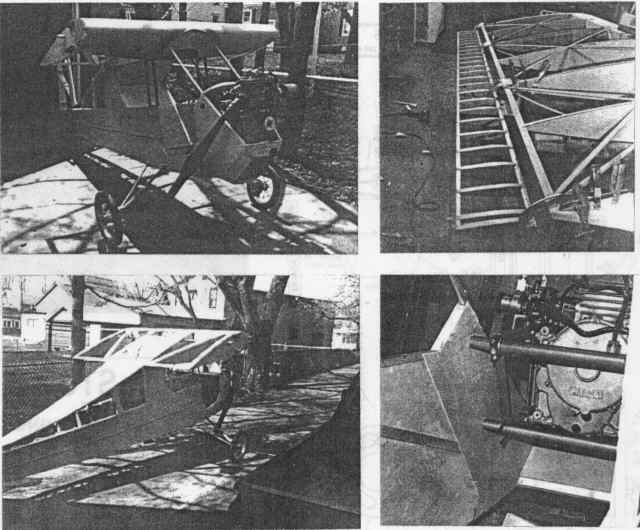
Robert Bryan of Saratoga, N.Y. sent construction photos of SN 1936 which he recently bought from the original builder, Gary Loucks of Bath, N.Y. The aircraft is completed and has been flown 70 hours over two years by the original builder. Gary has since completed, and is flying, a Hummel Bird with a Global engine. This Pup has many major modifications. Full span ailerons were added along with diagonal wing bracing and all the related hardware. The fuel tank is in the wing and the control stick is mounted overhead. Because the dihedral was not reduced, the effect of the ailerons is said to be minimal. The engine is a water-cooled Hiro 2-stroke with built in gear drive and the radiator is mounted in the nose. The engine mount and forward fuselage (with side door) is completely different.
These photos are not presented to encourage you to consider changes to the design! The Sky Pup is unique among ultralights in that it is very well designed with respect to its goals which are simple, low cost construction, combined with excellent performance and a rugged low maintenance airframe. Every detail was chosen after very careful consideration. Any changes will likely compromise some of the design goals. Instead, SN1936 serves to demonstrate the versatility of the wood and foam construction method. If someone wanted to spend the time and money on the appropriate engineering analysis, various configurations could obviously be built with wood and foam.
(newsletter no. 18)
Another Sky Pup from the Michigan Litter

Sky Pup SN2294 built be Greg Pardee from Owosso, MI is the 5th Pup from Michigan
to be reported in this newsletter (see newsletters no. 15 and 17 for preliminary
details). This bright yellow Rotax powered Pup made it's first flight on June 15,
1987, at the Owosso Community Airport. A group of friends and relatives were present
and the first flight was recorded with video camera. Greg says that building and
flying the Sky Pup was a very rewarding experience. The Pup took about 300 hours
to build, and cost about $2200. The covering is 1.6 oz. Dacron painted with yellow
polyurethane (sprayed on). A 2.5 gal. gas tank is mounted overhead, rear of the main
spar, and enclosed in a fuel proof box in case of a leak. The wheels are modified
16 inch wheelbarrow tires with aluminum covers painted to match the rest of the plane.
With a 54x34 prop he doesn't have a clearance problem. The fuselage at the landing
gear was reinforced with 1/4 inch Fir. He has installed a simple shroud on the cylinder
head which brings the temps down to the 340-350 range at cruise (which is 4900 RPM).
This winter he plans to add a small windshield. If you add Ray Macke's Pup, now owned
by Phillip Bond from Hastins, MI (newsletter no. 16), there are now at least six
Sky Pups flying in Michigan which could get together for a formation flight. Michigan
is still the "Land of the Sky Pup" with Kansas running a close second.
Some Tips on Color Selection
I would like to offer some advice about color selection for the Sky Pup, and all aircraft in general. The importance of color, for visibility to other aircraft, became very obvious while was flying at Oshkosh in 1987. There was a light blue biplane in the pattern which would sometimes disappear, even thought I was looking straight at it. It desperately needed some stripes or trim to make it more visible. Light colors are generally better, but for best results the aircraft should be of two contrasting colors. Dark colors may tend to heat up the airframe when the plane is parked outside in summer. If your aircraft will be a solid color, please consider adding some contrasting stripes which should be wide enough to be seen from considerable distance. Polyurethane enamel is best if you are using the clear varnish on pre-colored fabric, as on the prototype. If visibility is a problem, a strobe light will help a lot in hazy or low light conditions.
W. Keith Stacy from Buffalo, Iowa sent this photo of his Pup (SN1892). The fuselage an leading edges are blue, and the wings and tail are white with red trim. This paint scheme should give excellent visibility, especially for aircraft approaching from behind. The engine is Kawasaki 340 and he is still lacking the fuel system, instruments, and minor details. He hope to have it at Oshkosh this year, if he can get the necessary time flown off (7 hrs) and obtain kind of transportation. More details later.
Miscellaneous
Mark Walker and Jim Carpenter from Tampa, FL report that their Sky Pup project is nearing completion. As of January, they have started fabric covering and hope to have it flying in time for the Sun-n-Fun fly-in at Lakeland, FL, in April.
Wanted: any and all Sky Pup components, finished or not, cash or trade. Write to John Komlosy, 4132 Vincente St., Fremont CA 94536. He has an engine and most of the hardware and landing gear but wants to buy airframe components to help save time and money.
Fabric cutouts for the tiedown straps can be closed with an inspection cover like those use elsewhere on the airframe, according to Newton Borden. He covered over the straps and the glued on plastic rings to fit the inspection covers. The hole is then cut out for the strap. Fabric doublers should still be used. Keep the clips on the covers running fore and aft to keep the airstream from lifting them.
OSHKOSH '88 is July 29th to August 5th. This year, the entire ultralight area will be move southward to accompany the new runway extension. There is some talk we may be using the end of the new runway. I will have early details of the new layout and advice about the best camping spots in the next issue (April '88).
IN MEMORIAM: It is with sadness I must announce that Leroy Thomas of Belfast, Maine passed away December 17, 1987. He was 71 years old. His Pup (SN2469) was featured in newsletter no. 11 and 15, and is pictured on the address side of this newsletter (see below). His wife wrote that Roy loved his Pup, and enjoyed it very much.

SKY PUP NEWS
Newsletter No. 17 October, 1987
- Sky Pup Rendezvous in Quebec
- The Don Palmer Story
- Bomber Pilot Flying Again
- Air Update from Cecil Boswort
- More News from Around the Litter
- Miscellaneous
- Stick Modification
- Tips on Engine Mounts and Vibration
-------------------------------------------------
SKY PUP NEWS is a quarterly newsletter for builders of the Sport Flight “Sky Pup”. the purpose of the newsletter is to provide for the open exchange of information and to encourag builders to share their experiences of building and flying the Sky Pup. Beginning with thi issue, the newsletter will be written by Sky Pup builders and enthusiasts. Unless specifically stated, all ideas, suggestions and building tips are strictly the opinion of the contributor and have not been approved by Sport Flight Engineering Inc. No warranty is made as to the airworthiness or suitability of modifications or building tips. When in doubt, you should follow the plans as close as possible and contact Sport Flight Engineering if you have questions. SKY PUP NEWS is compiled and distributed by Dan Grunloh…Rt 2, Box 82, Potomac, Illinois, 61865. Subscriptions are $7.00 for the calendar year ($10.00 overseas). If you want to talk about the Sky Pup, or about airplanes and homebuilding in general, please feel free to call m at (217) 569-2121 late evenings. Please keep sending your letters and photos.
Sky Pup Rendezvous in Quebec
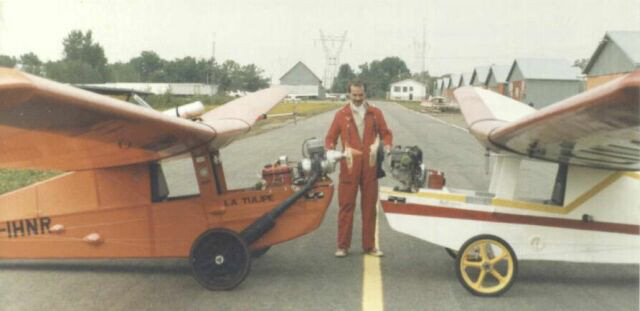
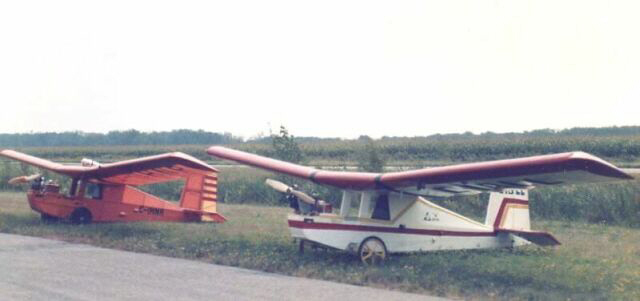
This is the story of three Sky Pup builders: Paul Pontois (SN2236 newsletter no. 13), Regi Castonguay (SN1307 newsletter no. 5), and Jean-Claude Hivon (SN2666 newsletter no. 13), who decided to meet and fly together on Sunday, September 16, 1987. Regis, who was the first to fly a Sky Pup in Canada, lives in Rinouski which is 300 miles from the Louisville area where Paul lives. He decided to trailer his Pup to Jean-Claude's farm in La Perade, which is only 70 mile from Louisville. From there he and Jean-Claude would fly to Louisville and visit Paul. On Saturday, Regis towed his Pup to La Perade which gave the two families the opportunity to visit and make acquaintances. After mounting the wings on Regis's Pup, the two friends flew around Jean-Claude's farm landing strip. Unfortunately, there was a strong crosswind and Jean-Claude damaged his landing gear. Only one Pup would make the trip to Louisville! On Sunday morning, Regis took off followed by Jean-Claude and his brother in a 2-seat Beaver ultralight, and by the family following by car. There was a 15 mph headwind so the trip took almost 2 hours. Paul says it was nice to see Regis again because it was the experience of seeing Regis' first flight 3 years ago that motivated him to build his own Pup. (Incidentally, I just received letter from another Canadian builder, Andre St-Pierre, who decided to build a Sky Pup after seeing Paul fly.) After a family picnic (13 persons), and in spite of the wind gusting up to 20 mph, Regis and Paul flew together around the small city. The first known photo of 2 Pup flying together is reproduced on the back page (address side) of this newsletter. The photo above shows Regis comparing his Kawasaki to Paul's Rotax. The return trip to La Perade took only one hour as they now had a strong tailwind. Paul says the Sky Pup is very popular in Quebec. In addition to these 3 Pups, there are 4 more under construction or nearing completion.
The Don Palmer Story
The previous newsletter reported that Sky Pup SN1145 owned by Burt Howland was flying in Maryland, NY. No details were available, but the builder was known to be Don Palmer of Schenevus, NY. I recently received a letter and photos from Don which provide additional details. SN1145 is yellow and white with a red nose and is Cuyuna powered. Mr. Howland, the current owner, was a former Navy test pilot and engineer. He also owned a Grumman Bearcat and a Cessna UC-78 twin. Since acquiring the Pup, he has built two original ultralight designs; a low wing and a biplane. The real story, however is about Don Palmer. Besides the Sky Pup, he has built three homebuilts and rebuilt four regular aircraft. After selling Sky Pup #1 to his good friend Mr. Howland, he started on another Sky Pup. Before it was actually completed, it was sold in kit form. He lost track of the buyer and has never heard if the Pup was actually completed and flown. Don says this last winter the old bug got to him again and yes, Pup #3 was started. He says he doesn't work anymore and is always building parts, etc for someone. Don wants to sell the partially completed airframe and materials kit for Pup #3. The tail unit is ready to cover with hardware in place. The engine mount and all steel and aluminum part are complete. Fir spar caps, fuselage wood, bearing blocks, and hardwood parts have all been cut. He has full size templates for the fuselage sides and wing ribs. The complete package with some plywood gussets, a bolt of fabric, and the plans and construction manual is for sale for $495.00. If you are interested, write to: Don Palmer, RD #1 Box 206, Schenevus, NY 12155.
Don sent a number of interesting building tips and ideas for modifications:
1. Mix aluminum powder in your polyurethane and paint all exposed foam for ultraviolet protection. When all foam has two coats, you can apply your covering with standard aircraft cement, which saves time.
2. Use Ceconite 7600 covering since it will not sag in cool, wet weather.
3. He used solid "popcorn" foam to shape the forward wingtip compartment because he had trouble with the fabric covering on the oval tip. He suggested eliminating the wingtip bows and using a flat wingtip faced with .8 plywood.
4. Install two 5-quart plastic fuel cans from K-mart on each side of the fuselage behind the main spar with an on-off valve on the instrument panel.
Bomber Pilot Flying Again

This Pup was built by Raymond Maynard of Traverse City, Michigan. The colors are blue and orange with black wheels. The engine is a Rotax 277 with a Culver 60x28 propeller. The empty weight is 225 lbs. Douglas Fir was used throughout the airframe and the finish is acrylic latex paint instead of varnish. Ray was a bomber pilot in WW-II. He flew 30 combat missions in a B-24 with the 8th Air Force. He says he will be 64 years old in November and that it feels great t be flying again after 42 years. The Pup flew just fine with no surprises or disappointments.
(Edwin's note: I spoke with Raymond's wife today, July 18, 2003, and he and two of his sons are going for a ride in a B-24 on Sunday July 18. The B-24 will be in the Traverse City, MI area for a week. Raymond sold his Pup and lost track of it.)
Update from Cecil Bosworth
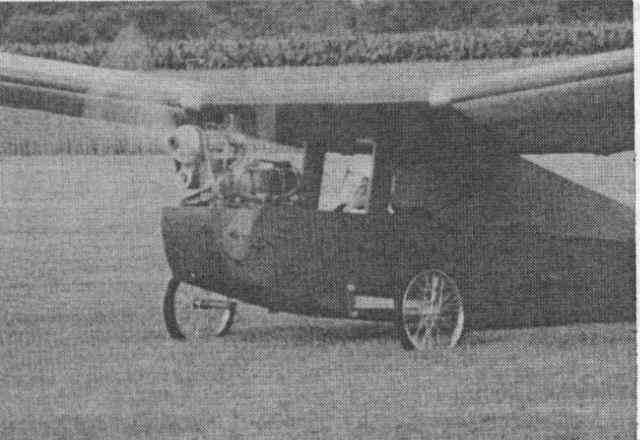
The photo at left is from Cecil Bosworth of Charlotte, Michigan. See newsletter no. 11 (Apri '86). He has been flying his blue and yellow Lloyd powered Pup for three years. Though he ha some early problems, he has worked them out and now the Pup flies hands-off. Cecil is an old time pilot, mechanic, CFI, and former manager of the Fitch Beach Airport, Charlotte, Michigan. He is one of the many Sky Pup builders who has been grounded from flying regular aircraft due to the medical requirement. Cecil says he was at Oshkosh this year, but too early to see my Pup or talk with the other builders.
More News from Around the Litter
Greg Pardee of Owosso, Michigan (newsletter no. 15) phoned to say he has completed and flown his Pup which now has 6 hours on it. He installed a cowling on the cylinder head of the Rotax 277 for better cooling. The prop turns 6100 RPM with a homemade exhaust system which weighs only 3 lbs. The Pup flies nose-heavy with a CG of 7 inches and the stab adjusted. He installed a rudder trim tab and is currently flying with a tailskid as shown in the plans. Greg says the Pup feels very solid compared to his Quicksilver MX.
A.R. Clements from Sechelt, BC Canada, reports that his Sky Pup is completed and nearly ready to fly. He says the Rotax engine cost more than the complete airframe. The prop is 58x24 and the reduction ratio is 2.58 so he may need more pitch. (The standard prop for this combination is 60x28). His Pup was painted to have yellow-orange wings and tail, and a light green fuselage and rudder. Total building time was 500 hours. He also built a fully enclose trailer on a Honda car rear axle. Mr. Clements reports he is having difficulty obtaining permission to fly at his local airport. Though the airport is uncontrolled, the management requires that all aircraft be equipped with a radio. He also says the required ultralight license in Canada costs $600 with instruction. The engine has been broken in and he hopes to have the red tape cleared away so he can be flying soon.
Konig powered Pup for sale. Newton Borden writes that he is thinking of selling his Pup SN 2625 (see newsletter no. 9 & 15). He has about 15 hours on the Pup and enjoys it very much. Newton let a friend who owns a Long-EZ fly the Pup and his friend said it was the most fun flying he had ever had. He wants to sell it because he would like to start another project ( Fisher 404) but doesn't have room for both of them. The engine runs fine and burns about 1.5 gal. per hour. Cruise is 55 MPH and he has a 3 hour range with a 20 minute reserve. The Konig engine has very little vibration and features electric start. (The Konig and KFM engines require electric start because hand-propping or a recoil starter will not spin the engine fast enough to fire the plugs). Newton says that one day he felt some pretty good updrafts and his rate-of climb indicator was showing 700 FMP so he shut down the engine and did some soaring. This Pup is especially suited for power-off flying because you can restart the engine at the push of button. The asking price for SN 2625 is $3500. That may seem a little steep, but the Konig engine is quite expensive and the Pup has a very complete instrument panel. Photos of the Pup show excellent workmanship. If you are interested write to: Newton Borden, 11 Rainbow Lane, South Weymouth, MA 02190. (phone 617-335-2399).
Miscellaneous
Neil Huizenga of Grandville, Michigan is now the proud owner of Sky Pup SN 1092. This bird was the first plans-built Pup to be completed. The original builder was Ray Macke and the previous owner was Phillip Bond (see newsletter no. 16). Neil says he has always wanted something like this since he was a kid and built model airplanes. He soloed in a Cessna 150 about 13 years ago and accumulated 25 hours of flying time. He also completed A&P aircraft mechanic training in the early 80's. Neil says he has taxied and hopped the Pup for probably more than 2 hours but has not yet been over 15 feet above ground. Unfortunately, he got into hurry when turning around at the end of the runway in deep grass and dug the prop into the ground. The engine was at idle so the tips of the prop were only slightly damaged.
Several builders have reported difficulty with the fabric covering on the wheels. Apparently, the wheel contracts slightly when the tire is inflated resulting in wrinkles and slack in the fabric. If the fabric is shrunk and varnished after the tire is inflated, much better results are achieved. However, if you have a flat tire or otherwise deflate the tire, the rim expands slightly and may then pop or tear the fabric loose. Plastic wheels may be worse but the effect has also been reported with metal-spoked wheels.
While at Oshkosh this year, I mentioned to one of the other builders that the lower wing fabric bay which has the cutout for the tiedown strap seems to bulge upward slightly while in flight. had assumed it was due to slack in the fabric. He reported that it can easily be cured by sealing off the hole better. The effect is actually due to a partial vacuum inside the wing bay caused by the airstream rushing by the hole. Sure enough, when I closed over the cutout temporarily with tape, the upward bulge disappeared. I can't remember who it was, but"Thanks for the tip".
SOME TIPS ON ENGINE MOUNTS AND VIBRATION
Here's some information about engine mounts obtained from Ron Schettler at the Rotax forum at Oshkosh '87. Anyone considering designing their own aircraft or making changes to the Sky Pup engine mount should consider the following facts. An engine mount which is too soft or too loose may absorb vibration well but may also absorb power which should be going to the prop. Most of the power produced by the engine is delivered during a very short time in the engine cycle. If the engine is free to move the opposite direction of the prop during that short pulse, a considerable amount of power can be lost. Mr. Schettler cited a specific example where the static thrust of a well-known ultralight was increased from 180 lbs. to 220 lbs. just by moving the engine mounts farther apart. Nothing else was changed. The entire problem is very complicated and includes the "softness", rebound time, spacing of the mounts and engine RPM. It's largely a matter of trial and error to find the best combination. The best approach is to stick with a mount which has been proven to work well. After attending the forum, it was interesting to inspect the engine mounts of the various ultralights at the convention and to note their takeoff and climb performance. The correlation was amazing. Certain ultralights which are known for their sluggish performance have very nice soft mounts which absorb vibration very well. Their owners often end up adding larger engines to get the needed power. It seems that everything in aviation and aircraft design involves a compromise.
In an attempt to reduce vibration on my Rotax powered Pup, I made a small change. In place of the black rubber stoppers, I used white pure gum stoppers which are softer and more resilient. They seem to help and I haven't noticed a reduction in power. So far, I have about 50 hours on the first set. If anyone is interested, I can supply them at the wholesale price of .45 each or $5.00 per dozen.
One final note. I recently mounted a different propeller on my Pup which is much lighter than the original Rotax prop. The Jeco prop from a Rotax 277 powered Eipper GT has a thinner hub and less blade area but the same diameter and pitch. The reduction in the mass of the wood which must be accelerated with each power pulse seems to have tamed the vibration a little more.
Just recently, I was quite relieved to have my first forced landing in my Sky Pup. The Rotax had been running perfectly for almost two years and 80 hours of flying without a single burp. The problem turned out to be worn carburetor float guides which caused them to stick and flood the carburetor and engine. Raw fuel was spraying in my face from the carburetor vent tubes and the engine would not run above 4000 RPM... not quite enough to maintain altitude. A precautionary landing in an open field was the best choice as I was still several miles from the airport, and it was almost dark. Examination of the floats showed that the aluminum inserts in the float guide holes were worn thin. The brass guide pins mounted in the float bowl were also noticeably worn. Though it was not obvious that the floats might stick, they apparently could wobble enough to become jammed. I presume the ultimate cause of the wear is engine vibration. (A complete carburetor float bowl kit is available from Rotax distributors.) Before replacing the parts, I tried to get the problem to repeat itself while on the ground. I was unsuccessful even after propping the tail up to cruise attitude. Hopefully, this experience will help motivate me to always have that emergency landing spot in sight.
(newsletter no. 17)
Stick Modification

SKY PUP NEWS

Newsletter No. 16 July/August, 1987
- New York State Pup
- Report from Oshkosh '87
- Saskatchewan Pup Flying
- News from Around the Litter
- More News from Around the Litter
- Crosswind Landing Tips
-------------------------------------------------
SKY PUP NEWS is a quarterly newsletter for builders of the Sport Flight “Sky Pup”. the purpose of the newsletter is to provide for the open exchange of information and to encourage builders to share their experiences of building and flying the Sky Pup. Beginning with thi issue, the newsletter will be written by Sky Pup builders and enthusiasts. Unless specificall stated, all ideas, suggestions and building tips are strictly the opinion of the contributor an have not been approved by Sport Flight Engineering Inc. No warranty is made as to the airworthiness or suitability of modifications or building tips. When in doubt, you should follo the plans as close as possible and contact Sport Flight Engineering if you have questions. SKY PUP NEWS is compiled and distributed by Dan Grunloh…Rt 2, Box 82, Potomac, Illinois, 61865. Subscriptions are $7.00 for the calendar year ($10.00 overseas). If you want to tal about the Sky Pup, or about airplanes and homebuilding in general, please feel free to call m at (217) 569-2121 late evenings. Please keep sending your letters and photos.
Dear Subscriber: It's been a busy summer with lots of flying. I had a great time at Oshkosh! This issue is late as usual but most of the news was collected while at the big convention. Be assured you will receive four issues per year even if the schedule is somewhat erratic. I will definitely need more letters and photos from you the pilot and builder before I can start on the next issue. You can always call me and report any interesting ideas, flying stories o construction tips you might have. I can do the writing. The number of subscribers has been steadily increasing so I know you're out there.......
New York State Pup

The Sky Pup shown above has a spotted dog painted on the side of the fuselage and was built by Tom Woods and Ron Jones from the Norwich, NY area. The Pup has been flying for three years. The engine is a twin cylinder opposed OMC 437cc which produces 25 HP. The engine was adapted from an Evinrude snowmobile and is fitted with a homebuilt belt drive. the fuselage is blue and the wings and horizontal tail surfaces are yellow. The Pup was originally flown with a smaller OMC engine of about 15 HP but proved to be underpowered. The total cost to build the Pup was only $1400. In addition to a fuel tank in the centersection, a wind vane type airspeed, and a steerable tailwheel, this Pup has several interesting and unique modifications. There is no rudder bar! Instead the rudder cables are connected to a jointed stick and are routed inside the fuselage. Also the attachment of the wheels to the landing gear was changed and aluminum fairings are added which streamline the axle and landing gear. Their Pup has a curved plywood cover over the instrument panel on the forward deck. The transport the "spotted dog" in an enclosed trailer with the wings mounted on top. Tom Woods, who lives in Oneonta, NY was at Oshkosh this year but the Sky Pup had to stay home. H reports that there is another Pup in Maryland, NY which is owned by Bert Howland. That Pup is SN1145 which was built by Don Palmer of Schenevus, NY.
Report from Oshkosh '87

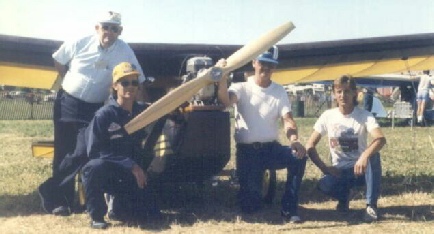
The photo on the left shows my Pup SN2028 at the big show with no other puppies to keep it company. Gerry Coppock had planned to bring his for the third year in a row but family responsibilities had to come first. It was my pleasure and honor to represent and exhibit the Sky Pup and to meet all the enthusiastic builders and pilots who were there. On any one flight there were 10 times as many spectators as would see it back home over a whole year. The best part was sitting around Gerry's campsite in the evenings for a "bull session" with as many as 5 or 6 builders who are already actively flying. We are a unique group and I couldn't help notice that Sky Pup builders everywhere are just plain folks who share a sense of determination, independence, and a "can do" attitude. Some of us are more eccentric than others. On builder already flying didn't want to give his name or address or have his Pup reported in the newsletter. He said he is a loner.
The group photo on the right was one of several taken during the week. From left to right is: Norman Bang, Dan Grunloh, Gerry Coppock, and Brent Adams. Other builders at Oshkosh thi year included: Phillip Bond, Keith Stacy, Francis Scheffield, Newton Borden, Donald Diggs, Tom Wood, Gene Kerns, Tom Hogan, Dana Rauch, Jim Beattie, and Bob Schaeffer. Of the 15 builders I remember, 9 are already flying. My apologies to any one I may have forgotten but i was a very hectic week. According to my logbook I made 11 flights over a 5 day period. the first takeoff was the 99th for my Pup. It was a very proud moment for me. Early in the mornin before that flight, a few grains of sand were quietly and ceremoniously sprinkled onto the runway. Similar grains fell to the ground before the first flight at my home field. The small via was filled from the base of the monument on Kill Devil Hill at Kitty Hawk. It's not that I a superstitious, it's more of a tribute to the brothers who started it all. Wouldn't they have bee amazed if they could have obtained a set of Sky Pup plans, a raw materials kit, and a good 2-
stroke engine back in those days?
Few changes were made to SN2028 since it was reported in newsletter no. 12. A twin strob light system was installed to allow flying 30 min. after sunset. The kit from Illusion Strobe Co. of Aptos, CA was fairly easy to assemble and works well. One flash head is on the centersection trailing edge, the other is under the axle on a soft aluminum bracket which will bend in case of ground contact. One other addition is a one gal. removable fuel tank which clamps onto the wing attach upright. Originally from an Easy Riser, the tank brings the tota capacity to 3.5 gal. for those extra long flights.
Here's some tips if you ever plan to fly at Oshkosh. First have plenty of time in your Pup so you are competent and comfortable with it. When the pattern is to the south, you must make low right hand turn just before landing. If you are accustomed to a left hand pattern, a little practice in advance would be helpful. During the busy weekend periods there might be 30 or more aircraft in the pattern with flying speeds from 25 to 75 mph so you must stay alert. My only problems were with potential conflicts while taxiing. At one point, I could almost see the look of surprise on his face. In contrast the early Monday morning period was almost empty. had it all to myself. I will always remember the sights and sensations of my first takeoff a Oshkosh. I have been attending the convention since 1981 but had never seen it from the air.
Aerial photos of the site are not the same as seeing it for yourself from the cockpit of your own little airplane. That flight represents the achievement of a goal set 6 years ago. The experience was well worth the effort.
Saskatchewan Pup Flying

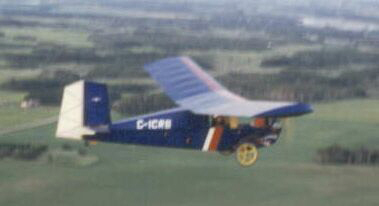
Sky Pup SN2302 built by Brent Adams of Saskatoon, Saskatchewan made it's first flight o June 4th, 1987. See newsletters no. 14 & 15. The wing damage from a trailering accident was repaired fairly quickly and the first flight was delayed only a few weeks. Construction was started in 1984 and Brent says the Pup was his first airplane project. The color is bright blu with red and white trim. Empty weight was 210 lbs with a fan-cooled Rotax 277. The prop is 60x28 Arrowprop with steel leading edge which survived a nose-over with no damage. the prop was removed from his "Beaver" ultralight when the Pup was ready to fly. He says the Pupflies much better and has a more solid "feel" than the Beaver (no doubt this is due to the abundance of nuts and bolts and other hardware connections on the Beaver as compared to the Sky Pup). The CG on his bird came out to 3.5 inches and it flies slightly nose heavy. mount for a Hall airspeed was built into the wing at about the tiedown position. A similar mount for a camera was also added prior to fabric cover. Here's a tip from Brent which is a refinement of the elevator control: if the elevators are adjusted to give about twice as much up elevator as down (as they should be), then at full forward stick the cable to the lower end of the elevator horn may develop some slack. Apparently the effect is due to the uneven geometry o the control movements and has not been a problem on other Pups which have showed this condition. The easy fix is to move the lower elevator cable and bushing up on the elevator horn (towards the hinge) by drilling a new hole. Find the best position by clamping the bushing to the horn temporarily. Brent says this adjustment evens out the cable tension throughout the range of control movements perfectly. He did make it to Oshkosh this year but without SN2302. Hopefully we will see this flashy toothsome Pup at some future convention.
News from Around the Litter
Phillip Bond of Hastings, Mich. is the current owner of the first plans-built Pup to be completed. SN1092 built by Ray Macke was reported in newsletter no. 1. Since acquiring the Pup, he replaced the prop and has had recurring problems with mismatched props and carburetor tuning. The engine is a fan-cooled Rotax 277 with belt reduction. A forced landing in a wheat field when the engine bogged down resulted in a broken gear, another prop ruined, and slight damage to the forward fuselage. Phillip is a certificated pilot and mechanic and has repaired the damage but is considering selling the Pup. If anyone might be interested, write t him at: 4409 Bayne Rd., Hastings, MI 49058.
David Beres formerly of Walla Walla, Wash. writes to say a change of job has forced him to move to Oregon. His Cuyuna powered Pup (SN1941) has accumulated 430 hours of enjoyably flying over four years. See newsletters no. 5 & 12. He is having trouble finding hangar space in the Salem area which is affordable. The high cost and taxes etc. seem to have a depressing effect on all of sport aviation. If anyone knows of ultralight activity or other grass root aviation folks in Oregon, please write to him. Dave says he has thought about possibly selling his Pup. The price would be $1200 to a good owner. His new address is: Dave Beres, 3837 Portland Rd., Salem, OR 97303
More News from Around the Litter
Gene Kerns from Portland, Oregon was one of several Sky Pup builders who I met for the firs time at Oshkosh this year. His Pup is unusual in that the engine is a Honda Odyssey mounted inverted out in front of the fuselage which was shortened somewhat for this purpose. He has shorter legs than most of us. Visibility over the nose is excellent. An engine failure resulted in a tree landing 60 ft above ground but only the fabric covering was damaged. Hopefully we will have more details and a photo in a future issue.
Rick Autry of Autryville, NC (see newsletter no. 6) sold his Pup some time ago and had been thinking of building a low wing version of the Pup. That idea proved impractical and now he wishes he could have his original Pup back. Unfortunately the new owner had wrecked an abandoned SN2176 so he has salvaged some metal and other parts and plans to start again. He is thinking of building a one piece wing which will have 31 ft long spar caps!
Pete Bloss of EAA chapter 564 in Allegan, MI graciously sent me a video tape of their club-built Sky Pup flying with a Lloyd engine and with a Rotax 277 they installed later. See newsletter no. 7 & 8. A unique feature on their Pup is a small nosewheel installed to prevent prop damage in case of a nose-over. Also Newton Borden shot some video of my Pup at Oshkosh s eventually we might build up a collection.
Keith Stacy of Buffalo, IA sent a mockup of the control hinge detail on his Pup SN1892. A ¼ inch diameter wood dowel has been inlayed into the hinge foam at each mating edge. Sandpaper was wrapped around the dowel to make the inlay. The dowel was then taped in place and the hinge was hotwired to the correct shape. This method could save lots of time spent shaping and sanding with very little added weight. At Oshkosh, Keith had photos of hi Pup which showed the fabric covering nearly completed. The colors are blue and white.
CROSSWIND LANDING TIPS
By Dan Grunloh
Having flown Sky Pup SN 2028 for over 60 hours in various wind conditions, I want to pass on some observations. My Pup has a tailskid and I operate mostly from unpaved grass landing strips. Also I have installed smooth tires on the wheels in the hope that they might slide sideways a little on landing if needed. Your Pup may handle differently so the following suggestions should be taken only as personal observations on my part. I had minimal prior experience in 3-axis controlled aircraft and this may have been an advantage when flying the 2-axis Sky Pup. The casual observer might think the Pup has no crosswind potential at all. I think you will be surprised that with proper technique, it can handle more crosswind than some so called 3-axis ultralights.
Briefly, for crosswind landings make a crabbing approach with plenty of airspeed and gently straighten it out just before touchdown. Wheel landings are best and you should keep the tail up and the aircraft rolling straight ahead until it slows down.
The important thing you must have is plenty of airspeed. A faster approach reduces the amount of crab angle needed and gives quicker control responses which may be needed for turbulence near the ground. A faster landing also reduces the amount of drift the landing gear might be exposed to. In a strong 45 degree crosswind the groundspeed will be reduced considerably anyway. Do not “kick out” the crab suddenly or the upwind wing will lift and result in a one-wheel landing. It’s easier than it sounds because there is almost always a noticeable wind gradient very close to the ground. The wind gradient does much of the work for you. Gradually reduce the crab angle as you descend through the gradient in whatever amount is needed to maintain a straight ground track. It all happens fairly quickly but with practice it becomes a smooth natural transition. For me this occurs at about 6 to 10 ft. above ground during the roundout portion of the landing. The actual flare should be very minimal as this is supposed to be a wheel landing. I always leave some power on and if the wings aren’t level or the aircraft isn’t aligned with it’s ground track I have two choices. I can add enough power to fly level and try to straighten it out or I can climb back to pattern altitude and try again.
Now for the most important tip in this whole article. Often during or after touchdown the upwind wing will start to lift and the Pup will start to yaw into the wind while still rolling fast. This usually indicates that you are landing too slow, flaring too much, or letting the tail down too soon. At this point there is a moment of confusion because your learned response is to use the rudder to lower the wing. That action will yaw the Pup even further from it’s direction of travel and place excessive side loads on the gear. Instead, use the rudder to keep the Pup going straight and lower the wing by getting the stick forward and keeping the tail up. This reduces the angle of attack and destroys the extra lift produced by the upwind wing. There isn’t much time to think about it when it happens and the wrong response will make the situation more unpleasant in a hurry. In strong crosswinds the Pup will tend to curve into the wind as you slow down. When possible you can try to land at an angle to the runway to reduce the drift correction needed. On narrow runways I find this difficult so I usually make a straight in approach. Direct 90-degree crosswinds are the hardest. My personal limit is about 10 mph for a direct crosswind and 15 mph for a 45-degree crosswind. On narrow paved runways my limits are lower. Wide runways with no obstacles allow you to land in almost any direction.
For crosswind takeoffs use the same techniques as for landing. Keep the tail high and delay liftoff until both wings are ready to fly. If you takeoff too soon the Pup may sink back to the ground in a drift and damage the gear. If the upwind wing starts to lift in spite of forward stick then let it. Use the rudder to keep it rolling straight ahead and wait a few more seconds until the other wing is ready to fly. As you lift off allow it to crab into the wind and climb straight ahead over the runway. With the ample power provided by the Rotax, my Pup can easily handle more crosswind on takeoff than on landing.
Don’t get the idea that these techniques work perfectly all the time or even most of the time. Many ultralights would not survive the occasional hop, skip, and jump takeoffs and landings I have made in crosswind conditions. Most of the credit goes to the rugged and extremely stable landing gear of the Pup. Its wide gear track, the low overall CG, and reluctance to groundloop, or drag a wingtip, result in very forgiving and tolerant landing characteristics. A traditional ultralight with small diameter wheels on a tricycle gear and a relatively high center of mass seems tricky in comparison to the Sky Pup.
Taxiing the Pup in a strong crosswind is another matter entirely. Because of the generous aft fuselage side area the tendency to “weathervane” into the wind is strong. I have made good landings and takeoffs in crosswind conditions in which I could not safely taxi. Turns at the end of a narrow runway can become impossible in a strong crosswind if the grass is deep or the ground is rough. Sometimes you just have to swallow your pride, climb out, and push it by hand. After all, it’s the flying that really counts.
A steerable tailwheel would probably handle crosswind conditions better. I like the skid because it is rugged, simple, trouble-free, and may help reduce the landing rollout. A tailwheel is needed if your CG is well aft (7 inches or more) as it becomes difficult to lift the tail enough with forward stick for taxi turns. Also realize that as the CG moves aft, the groundlooping tendency will increase. If you do install a steerable tailwheel, please make provisions so that side loads on the tailwheel will not be transferred to the rudder horn or the hinge fabric. A builder at Oshkosh said he is using a swivel tailwheel from a skateboard which he says works fine. Conventional wisdom is that a free swivel tailwheel would be the least stable configuration but it may depend upon the individual pilot, aircraft and operating conditions.
In closing, I do not wish to seem to encourage anyone to attempt difficult crosswind landings. There are times when it can take 3 or 4 landing attempts to get back on the ground when turbulent conditions are a problem. Sometimes you get lucky and the landing attempt occurs at the same time as a lull in the wind. You may have to land in a nearby hayfield or go to an alternate airport if the wind changes or increases during the flight. I do admit to planning cross-country flights based on the wind direction and the runway available at my potential destination. Doesn’t everybody? In actual practice I routinely fly with several high performance ultralights which have far greater crosswind potential due to their full span ailerons. The average ultralight pilot however wisely chooses not to use that potential because of the skill required and for fear of damage to their fragile $6000 to $8000 flying machine. For many recreational pilots the trade-off for this largely unused potential is the added concern for stalling and spinning while in slow flight.
Here’s one last tip about crosswind landings. Beware of cold winter days and flat clean terrain when there is little or no wind gradient to diminish the crosswind component. It can be quite a surprise as even light crosswinds are challenging.
I would appreciate very much hearing about your experience.
Good luck, and Have Fun.
(Sky Pup News No. 16)


